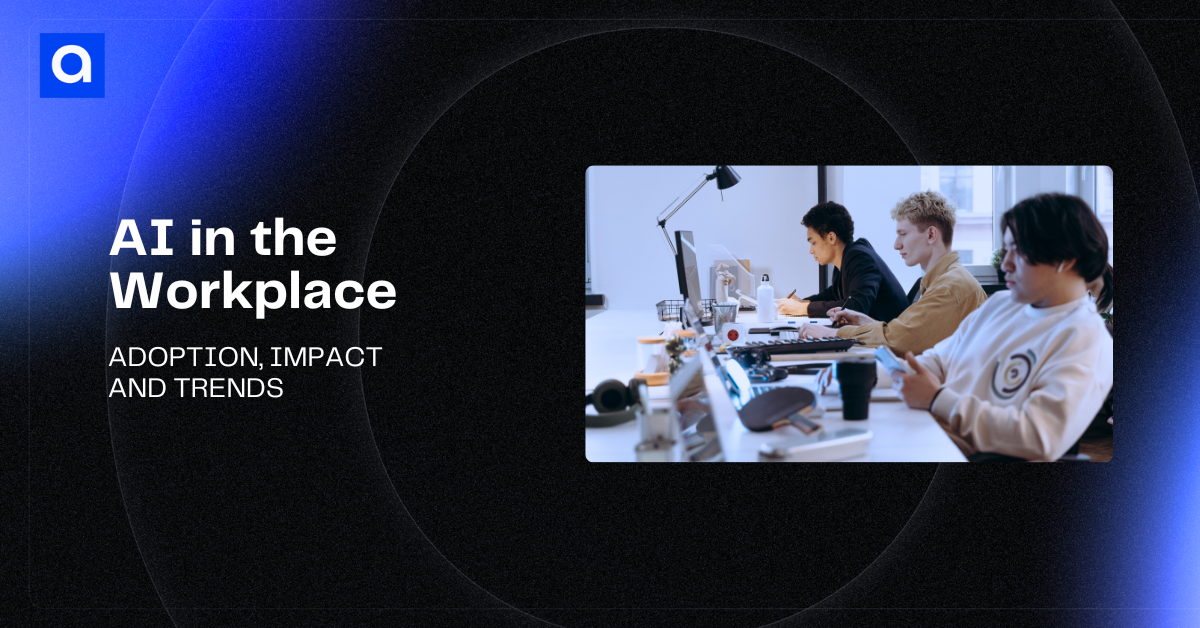
AI is changing the way we work. AI is reshaping how we collaborate, get things done, and stay competitive. According to the World Economic Forum, approximately 75% of companies globally are projected to adopt AI usage by 2027. Meanwhile, Deloitte forecasts that half of firms using generative AI will pilot ‘agentic AI’ systems by 2027. Employees are freeing up hours by automating repetitive tasks, businesses are experiencing noticeable boosts in productivity, and new job roles are popping up just as fast as others change or fade away.
To better understand this shift, we have decided to analyze and publish the latest trends and data to create statistics on how AI is used in workplaces. It’s designed to help professionals, business leaders, and job seekers see how AI is being used and what that means for the future of work. We think that understanding AI’s impact isn’t optional. It’s essential for staying competitive, future-proofing your career and business, and making smarter, faster business decisions.

Understanding AI's Workplace Revolution: A Data-Driven Reality Check
We're living through one of the most dramatic workplace transformations in modern history. Unlike previous technological shifts that unfolded over decades, artificial intelligence is reshaping how we work at breakneck speed often faster than we can fully comprehend its implications.
The statistics tell a remarkable story. In just two years, we've gone from AI being a curiosity in most offices to nearly universal adoption, with 91% of organizations now using at least one AI technology. But behind these impressive numbers lies a more complex reality that deserves careful examination.
The Paradox of Rapid Adoption
What makes this transformation particularly fascinating is its contradictory nature. Employees are simultaneously embracing AI tools while harboring deep concerns about their impact. From the data we have reviewed, we see roughly 65% of workers expressing optimism about AI's potential, yet 77% worry about job displacement.
While 58% of employees report regular AI use, an almost equal number (56-57%) admit to hiding their usage or presenting AI output as their own work. This suggests we're in an unprecedented period where the tools we rely on daily remain somewhat taboo or uncertain in workplace culture.
The Data Tells Multiple Stories
The research compiled here draws from diverse sources including Fortune 500 enterprises, small businesses, government pilots, academic studies, and global surveys. Each data point represents a different slice of our evolving relationship with AI. Some statistics capture the euphoria of early adopters saving 20+ hours per week, while others reflect the cautiousness of organizations still developing AI governance policies.
Rather than presenting a single narrative, these statistics reveal the multifaceted nature of AI adoption. A tech company's "AI integration" looks fundamentally different from a manufacturing firm's approach, just as a data scientist's daily AI use differs drastically from an HR professional's occasional assistance with email drafting.
Why This Moment Matters
We're capturing AI's impact at a unique inflection point. After the initial hype has settled but before long-term patterns have fully emerged. The data reflects both genuine transformation and growing pains, early wins and unresolved challenges. Most importantly, it shows us a workplace in transition, where old assumptions about productivity, collaboration, and human-machine interaction are being rapidly rewritten.
Key AI in the Workplace Statistics 2025
- 91% of employees say their organizations use at least one AI technology in 2025, 54% specifically use ChatGPT or generative AI. Source
- 77% of businesses are integrating AI: 33% have fully implemented it, 42% are exploring. Source
- 27% of corporate employees report frequent AI use, up 12% from 2024; top sectors: tech 50%, professional services 34%, finance 32%. Source
- Approximately 58% of employees regularly use AI, while roughly 31% use it weekly or daily. Source
- 56–57% of employees hide AI usage or present AI output as their own. Source
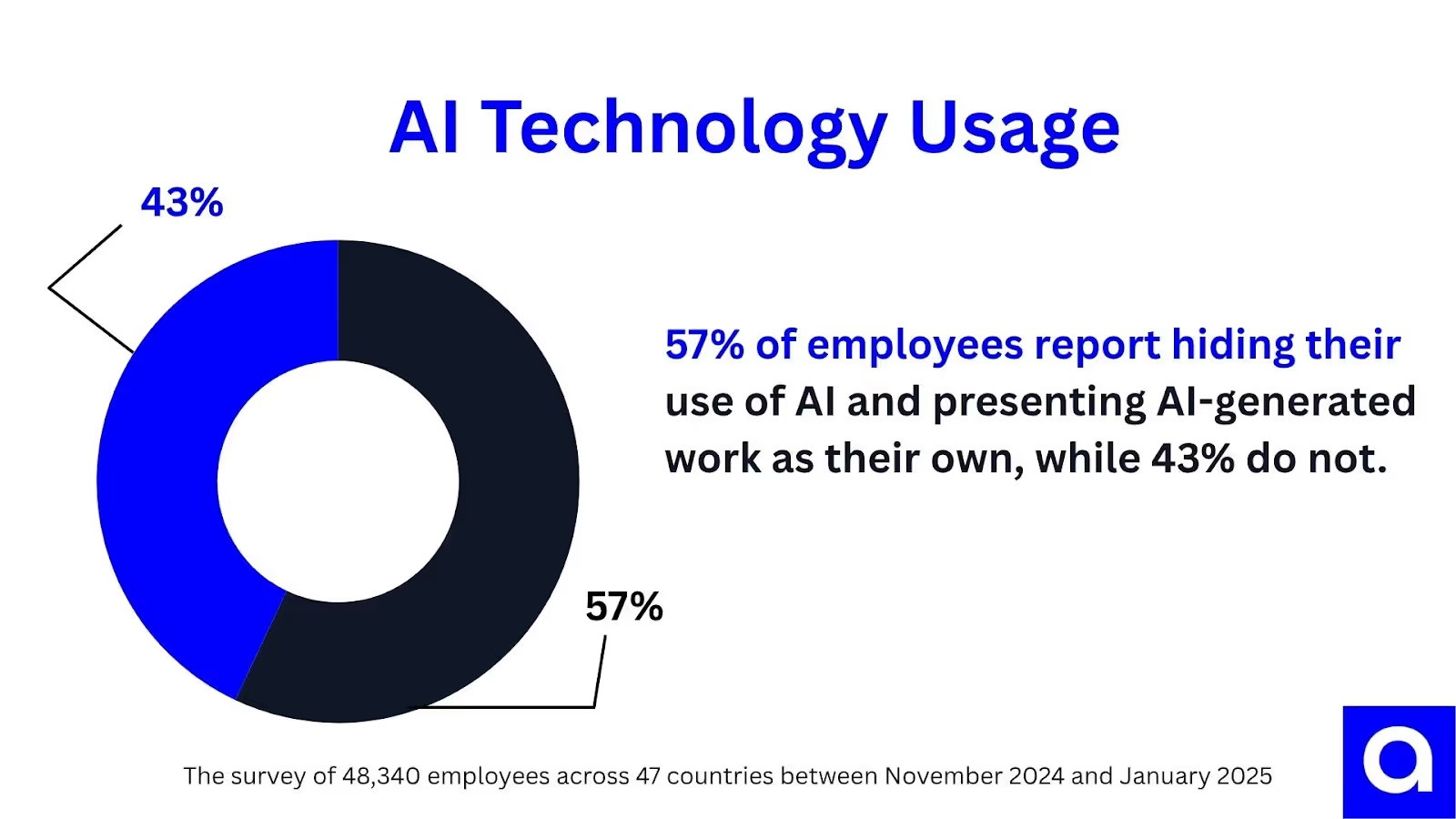
- 57% of employees admit to not checking for accuracy in AI-produced output. And a similar percentage admit to concealing their usage of generative AI in their workflow. Source
- U.K. administrative workers using AI could save 122 hours/year, or approximately £400 billion, according to a Google study. Source
- PwC data: wages in AI‑exposed industries are growing twice as fast as in non‑AI sectors. Source
The History of AI in the Workplace
AI's journey in the workplace began with early data driven automation tools and expert systems in the 1950s and 60s, but real momentum started in the 21st century with the rise of machine learning and big data.
As AI software development progressed, businesses began incorporating intelligent systems for data analysis, customer assistance, and process automation. Today, chatbots, voice assistants, all a host of “smart” tools that guess what you want before you even finish typing exist oftentimes unnoticeably.

How Is AI Used in the Workplace in 2025?
AI has become an everyday tool across industries, not just for IT teams or data scientists. From HR to finance, AI is transforming how we work, save time, and make decisions faster and sometimes better.
These tools help employees write emails, analyze trends, automate tasks, and even act as a virtual brainstorming buddy.
Writing & Communication
A Grammarly‑commissioned survey of 2,000 American knowledge workers found:
- 62% of respondents said there are tasks they’d like to use AI for—especially email drafting, spreadsheet sorting, and meeting-note summarization. Source
- 35% specifically want AI assistance with drafting emails. Source
- 33% want help drafting meeting notes. Source
Combined with other use cases, such as document generation, it supports the claim that 62% rely on AI for everyday writing and summarization tasks. Additionally, tools like Grammarly, ChatGPT, and Notion AI are frequently referenced as go‑to options for editing, rephrasing, grammar fixes, and summarizing content.
Administrative and Repetitive Tasks
AI saves workers 3.5 hours per week. It is automating tasks such as calendar management, spreadsheet organization, and data input. Today, many modern apps come with built-in automation features that help reduce the time spent on tasks that don’t add much value. Source 1, Source 2
Customer Service & Support
Customer support teams that utilize AI assistants see a 15% productivity boost, handling more tickets in less time. With minimal human involvement, it’s possible to manage FAQs, order tracking, and troubleshooting 24/7 with the help of Chatbots and AI voice agents. Source
Scheduling & Task Management
AI-powered digital assistants now handle everything from scheduling meetings to booking travel and placing orders. Tools like Google Assistant, Microsoft Copilot, and Sidekick AI are being used to reduce mental load and improve task flow.
Most Common AI Tools at Work
ChatGPT and generative AI platforms lead the way, followed by Grammarly, Google Gemini , Microsoft Copilot, Claude AI, Notion AI, and Jasper. A PWC 2023 survey revealed that more than half of the companies they surveyed, 54% had implemented early pilots of GenAI based solutions in some areas of their business. Source
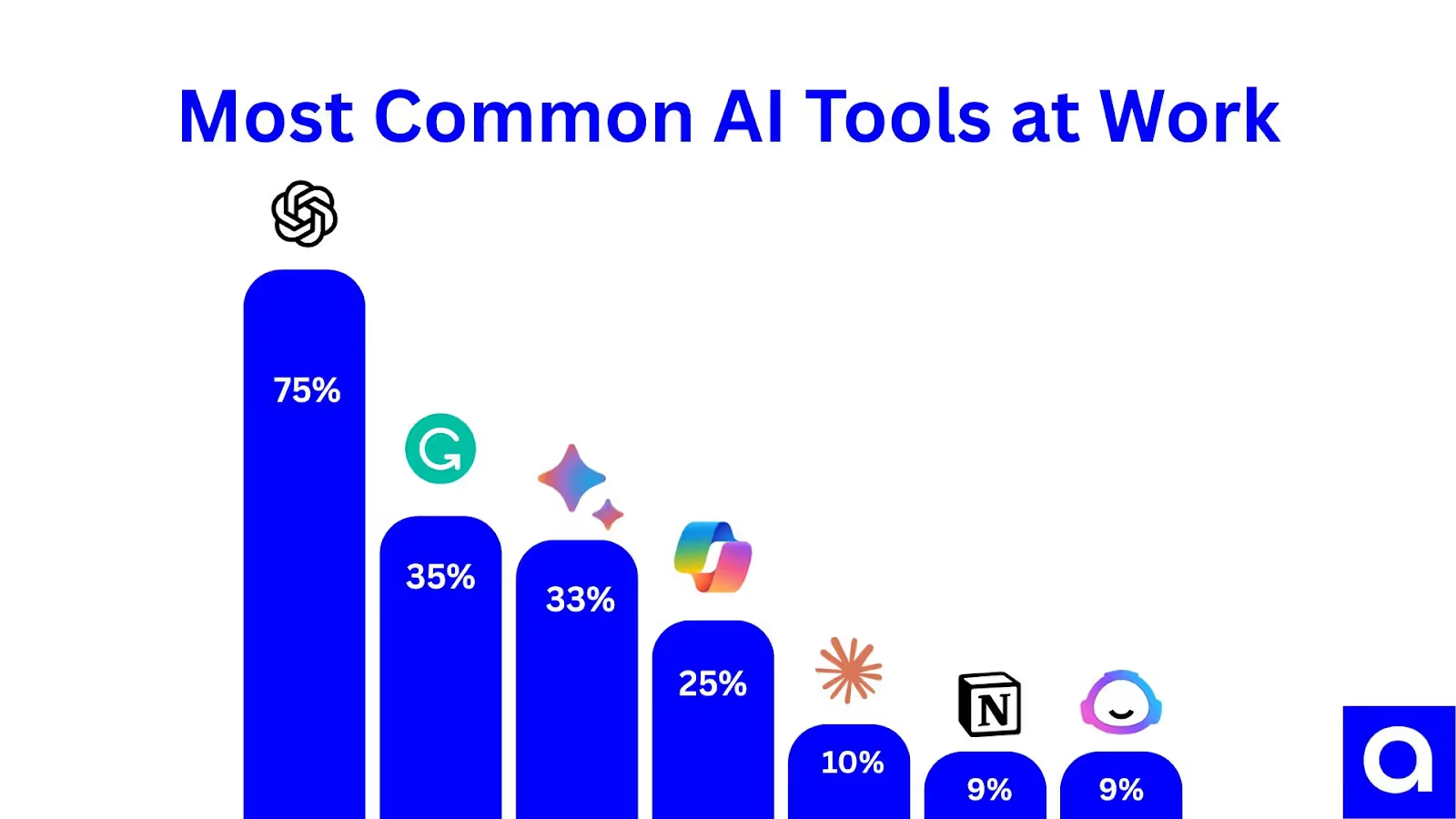
According to FlexOS (2024)
ChatGPT is among the most widely adopted AI tools for productivity, with usage surging across various sectors. Employees utilize it for drafting emails, summarizing meeting notes, generating reports, brainstorming ideas, and rephrasing content. It reduces cognitive load and saves an average of 1.5to 2.5 hours per week by streamlining writing and problem-solving tasks, particularly in marketing, HR, customer support, and software engineering.
- Over 800 million weekly active users globally as of July 2025, and OpenAI targets 1 billion users by year-end. Source
- Fortune 500 penetration: Over 92% have employees using ChatGPT, up from 80% in late 2023. Source
- Enterprise adoption: 1.5 million enterprise “seats” as of March 2025, a 10x increase in a year. Source
- Industry breakdown: Tech (28%), education/research (23%), business services (11%), and manufacturing (10%), with strong uptake in healthcare, retail, and government.
- US workplace use: 28% of US employed adults report using ChatGPT for work, double the rate from 2023. Source
- BYOAI trend: 78% of professionals using AI at work bring their own tools (Bring Your Own AI). Source
- Frequency: 36% of workers use ChatGPT at least monthly for work tasks; 22% use it daily. Source
A Productivity Accelerant
- Massive time savings: 27% of users save over 9 hours per week, with 18% saving more than 10 hours/week. For some “superusers,” savings exceed 20 hours/week. Source
- Average time saved: Employees report saving 1.5 to 2.5 hours per week on average, with some studies suggesting average daily time saved is about 1.75 hours—up to a full day per week.
- Task acceleration: Research from Harvard, MIT and BCG found consultants who used ChatGPT finished tasks up to 25% faster than those without AI, while HBR (Harvard BUsiness Review) reports task times can be cut by as much as 56%.
- Efficiency validation: A Pennsylvania State government pilot reported that 85% of government pilot users said ChatGPT made their work more efficient; 58% of tasks were completed in under 15 minutes when aided by ChatGPT. Source
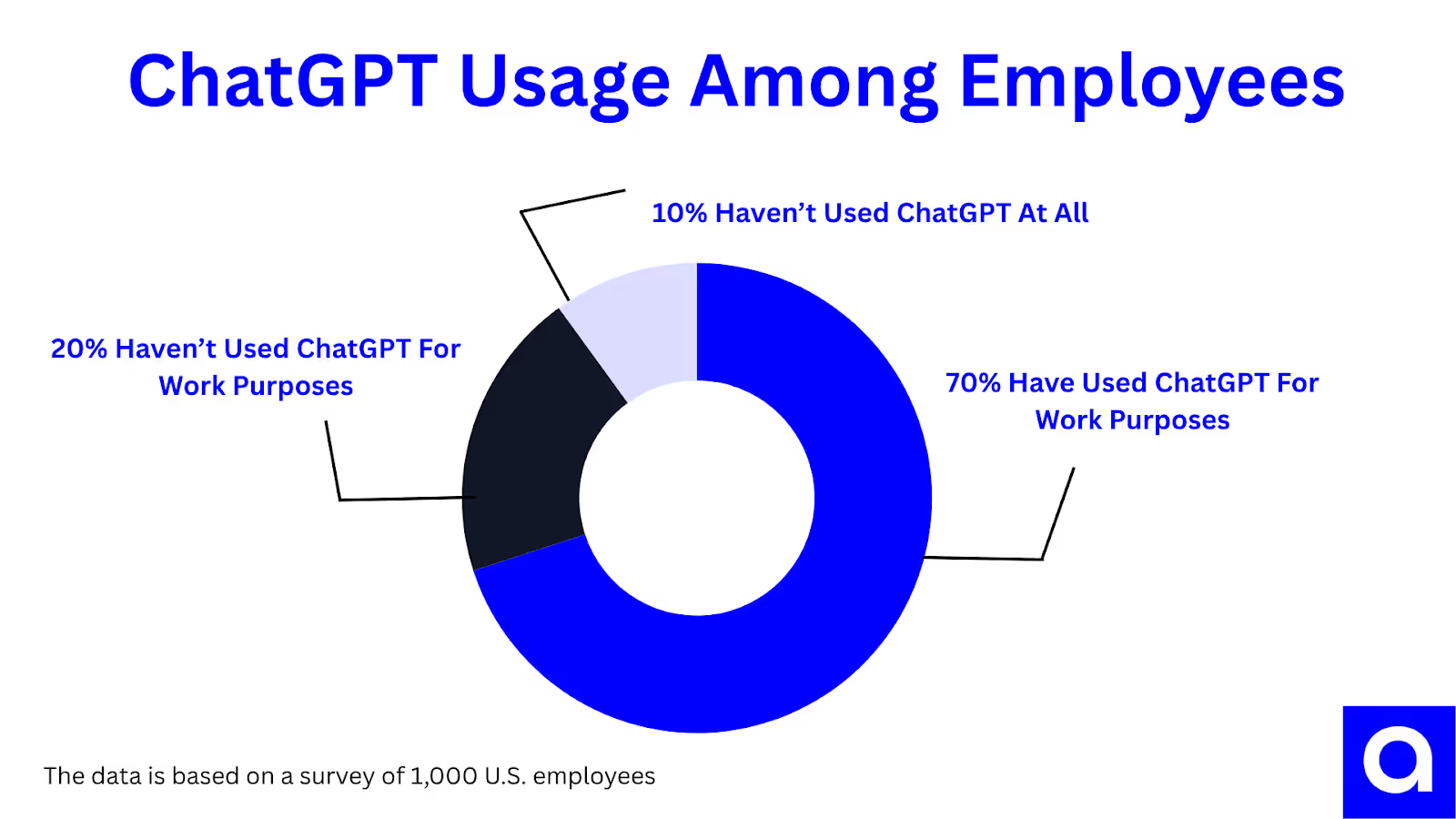
How Often Do Employees Use AI at Work?
AI has made its mark in the workplace, becoming a regular part of many employees' daily routines. What used to feel like a new experiment is now a go-to tool that helps streamline everyday tasks. This increasing use of AI shows a fundamental change in our approach to work.
Global Employee Usage
- 58% of employees report regular intentional use of AI tools at work.
- Among them, approximately 33% use AI weekly or daily.
Usage purposes include boosting efficiency (67%), information access (61%), innovation (59%), and work quality (58%)
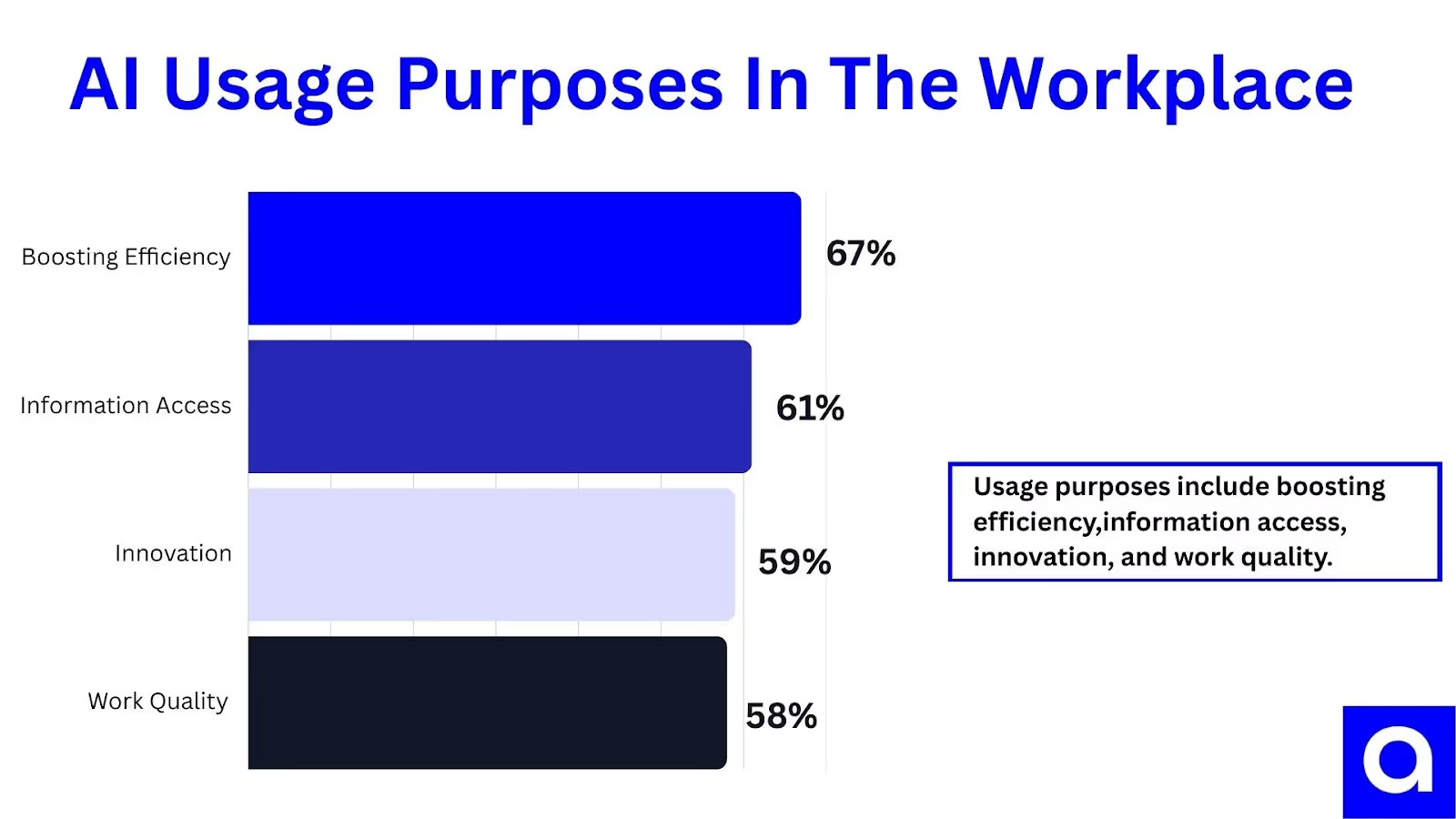
U.S. Employee Usage
- 12% of U.S. employees report using AI every day in their jobs for tasks such as email drafting, meeting summaries, and content generation were mentioned in the 2024 Eagle Hill Consulting survey conducted by Ipsos in June of 2024, which included 1,453 U.S. employees.
- A majority (58% of employees) say they never use AI at work, based on the same 2024 survey. Source
Generational Differences in AI Use at Work
In a recent survey, Millennials and Gen Z reported the highest rates of weekly AI tool usage, compared to Gen X and Baby Boomers. While this data reflects U.S. and Western workplace trends, similar generational patterns are emerging globally, as younger professionals lead the adoption of AI. Source
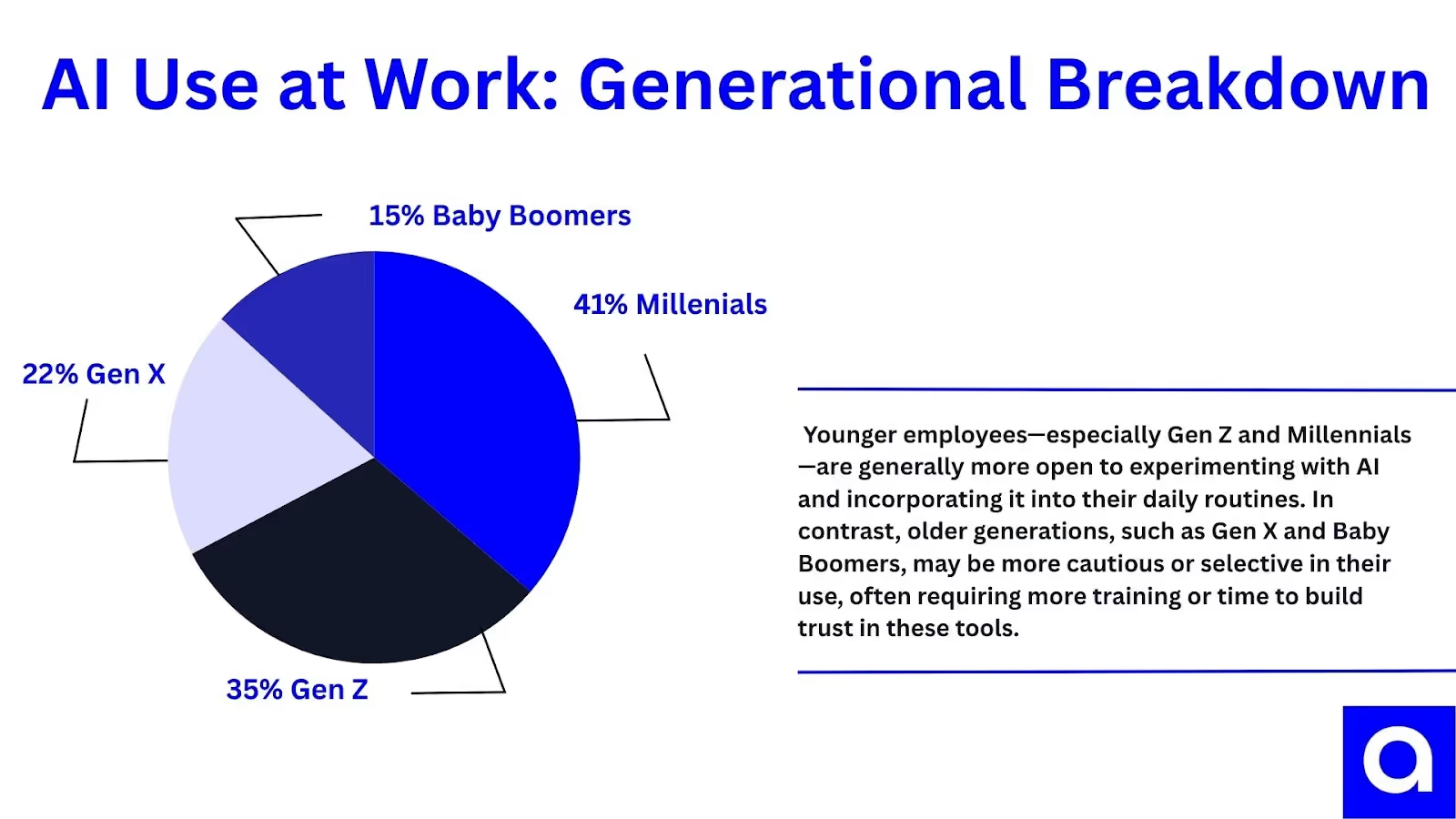
How Many Companies Use AI in the Workplace?
AI is spreading fast in workplaces worldwide, changing the way businesses run across all kinds of industries. Smaller companies are using it to automate everyday tasks. Big corporations rely on it for key operations. AI has truly become a must-have tool across the board. In this section, we’ll explore how different industries and company sizes are adopting AI, giving you a clear picture of its growing impact on today’s workforce.
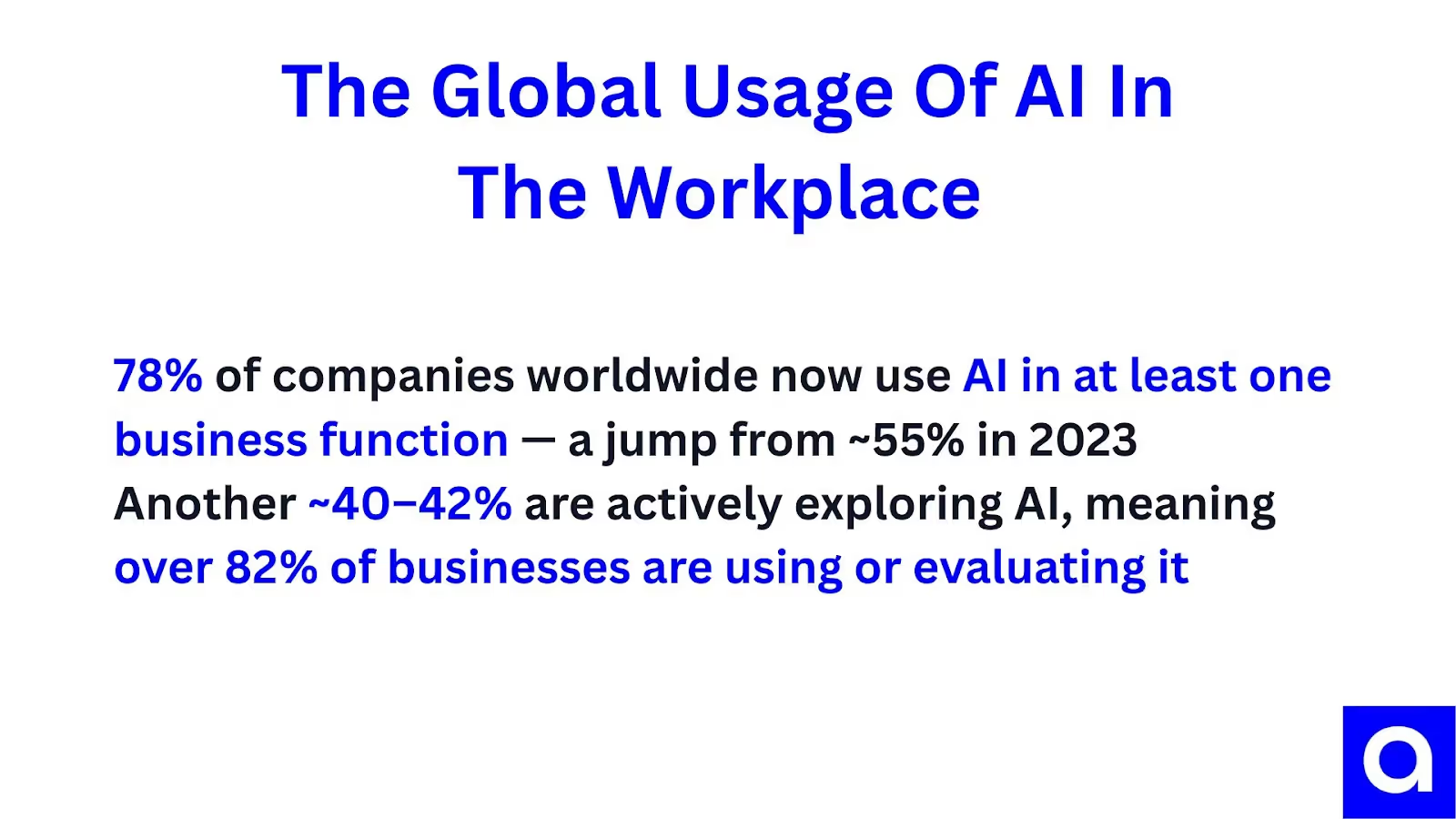
AI Usage by Industry: Which Sectors Use AI the Most?
AI adoption isn't the same across all industries; some sectors are using it rapidly, while others lag behind. Industries such as IT, finance, and healthcare are leading the way, integrating AI to boost efficiency, improve decision-making, and enhance customer experiences. At the same time, more hands-on or traditional industries have been slower to adopt AI, showing that there’s still a gap in how different sectors are experiencing the shift toward more innovative workplaces.
Leading industries:
- IT & Telecom: Adoption rates around 38-72%.
- Financial services: 50-65% usage.
- Healthcare: 22-58% usage.
- Retail & professional services: 30-49%.
Lower adoption in construction, agriculture, and manual labor sectors (often <10%)
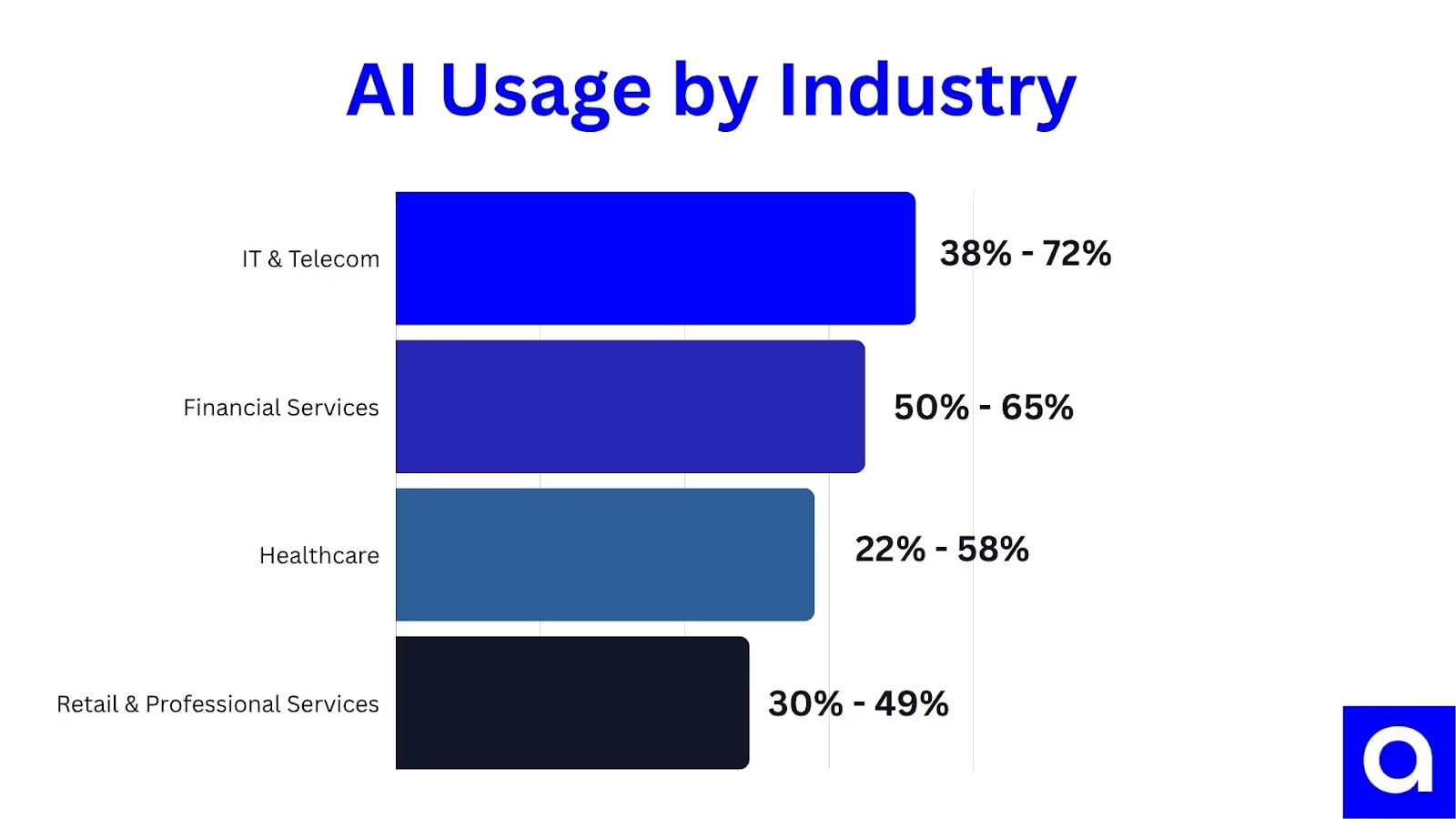
How Are Small Businesses vs. Large Enterprises Using AI?
- Large enterprises (5,000+ employees): 50-60% have integrated AI tools. AI integration is becoming increasingly common among large enterprises, with around 50–60% having already adopted it across different departments, from marketing and customer service to operations and logistics. These organizations are utilizing AI for tasks such as predictive analytics, customer service automation, and supply chain optimization. Their larger budgets and infrastructure make it easier to experiment with and scale AI technologies across teams and operations.
- Small businesses: Approximately 89% use AI for daily tasks, with 40–42% having formal plans or initial deployments. Surprisingly, small businesses are also rapidly embracing AI. Around 89% report using AI for everyday tasks such as content creation, customer communication, and scheduling. However, only 40–42% of them have formal AI strategies or are in the early stages of implementing them in a structured manner. While they may lack the scale of enterprise-level AI programs, small businesses benefit from the flexibility to adopt accessible, low-cost tools that deliver immediate value.
How AI Is Impacting Employee Performance and Collaboration?
In 2025, technology, particularly AI, is transforming the modern workplace, enhancing efficiency, streamlining workflows, and increasing overall productivity. AI tools automate repetitive tasks, such as data entry, email drafting, scheduling, and customer support, saving employees several hours each week. As a result, people can spend less time on repetitive tasks and more time on creative, strategic, and meaningful work. Teams collaborate more smoothly with the help of innovative tools and real-time insights, while companies make decisions faster and run more efficiently. It doesn't matter if it’s a small startup or a global brand, technology isn’t just something that supports the business anymore — it’s become a key part of how things get done and how innovation happens.
Enhanced Productivity & Performance
- 4x boost in productivity growth: Industries most exposed to AI (e.g., finance, software) saw productivity soar—27% growth from 2018–24, compared to just 7% before AI’s rise.
- 56% wage premium for AI-skilled workers: Employees proficient in AI commands in 2024 earned significantly more—56% above peers—while job numbers rose 38% even in AI-exposed roles.
- Support agents +13.8% more inquiries/hour; business professionals +59% more documents/hour. Programmers using AI completed 126% more coding projects weekly. At Azumo, we’ve seen this in several of the deployments of chatbots by our customers.
- GitHub Copilot users were 55.8% faster implementing tasks during experiments.
- Customer support saw 15% more issues resolved per hour with the help of generative AI assistants.
Stronger Collaboration & Teamwork
- 137% increase in communication between human-AI teams and 60% higher per-worker productivity in ad-generation tasks. Source
- AI-driven collaboration tools reduce redundant work by 35% and speed up knowledge retrieval by 70%.
- Organizations report a 25% increase in productivity when using AI-powered collaboration platforms. Source 2, Source 3
- Chatbots and assistants reduce communication delays by 45%. Source 2, Source 3
Performance Management & Engagement
- AI boosts feedback frequency by 40%, reduces bias, and increases performance review accuracy (68–77%).
- Real-time feedback via AI enhances team efficiency by 35%.
- Companies that use AI to track their goals often see real results, like a 25% boost in hitting their key performance targets.
What Do Employees Think About AI at Work?
Employee opinions on AI in the workplace are mixed but evolving. Many see it as a valuable tool that enhances productivity and reduces repetitive tasks. However, some express concerns about job security, data privacy, and over-reliance on technology. As AI becomes more common, employees are learning to balance its benefits with its potential risks. In reality in create this great AI contradiction that consists of both fear and fascination does in equal parts.
Ask any employee about AI at work, and you're likely to get a response that sounds contradictory: "It's incredibly helpful, but I'm worried about what it means for my future." This is a rational response of a workforce experiencing the most significant technological shift of their careers. As a firm that houses hundreds of knowledge workers we understand this concern at it core. We leverage these tools on a daily basis and deal with their power and pitfalls.
Employee sentiment toward workplace AI reveals something profound about human nature: our ability to simultaneously embrace a tool's immediate benefits while grappling with its long-term implications. Unlike previous workplace technologies that enhanced existing processes, AI feels fundamentally different because it mimics cognitive work—the very thing that defines many of our jobs.
Why Employee Opinions Matter More Than Ever
Traditional technology adoption followed a predictable pattern: companies decided, IT departments implemented, employees adapted. AI has flipped this script. Many employees discovered ChatGPT and similar tools on their own, experienced their power firsthand, and brought them into the workplace organically. This bottom-up adoption means employee sentiment is actively shaping how AI gets integrated into organizations.
The statistics that follow capture this unique moment where employees are simultaneously:
- Pioneers and skeptics - using AI daily while questioning its broader impact
- Beneficiaries and potential casualties - gaining productivity while fearing displacement
- Adopters and guardians - embracing efficiency while protecting their professional identity
Reading Between the Numbers
The data reveals three distinct employee populations emerging:
- AI enthusiasts who see transformative potential and worry they're not moving fast enough
- Cautious adopters who use AI selectively while maintaining healthy skepticism
- Resistant observers who prefer human-driven processes and worry about over-dependence
None of these positions is inherently right or wrong. They reflect different values, risk tolerances, and workplace contexts. Understanding this spectrum helps explain why employee sentiment data often appears contradictory when viewed through a single lens.
What emerges is a portrait of a workforce that's more thoughtful and nuanced about AI than simple "pro" or "anti" categories suggest.
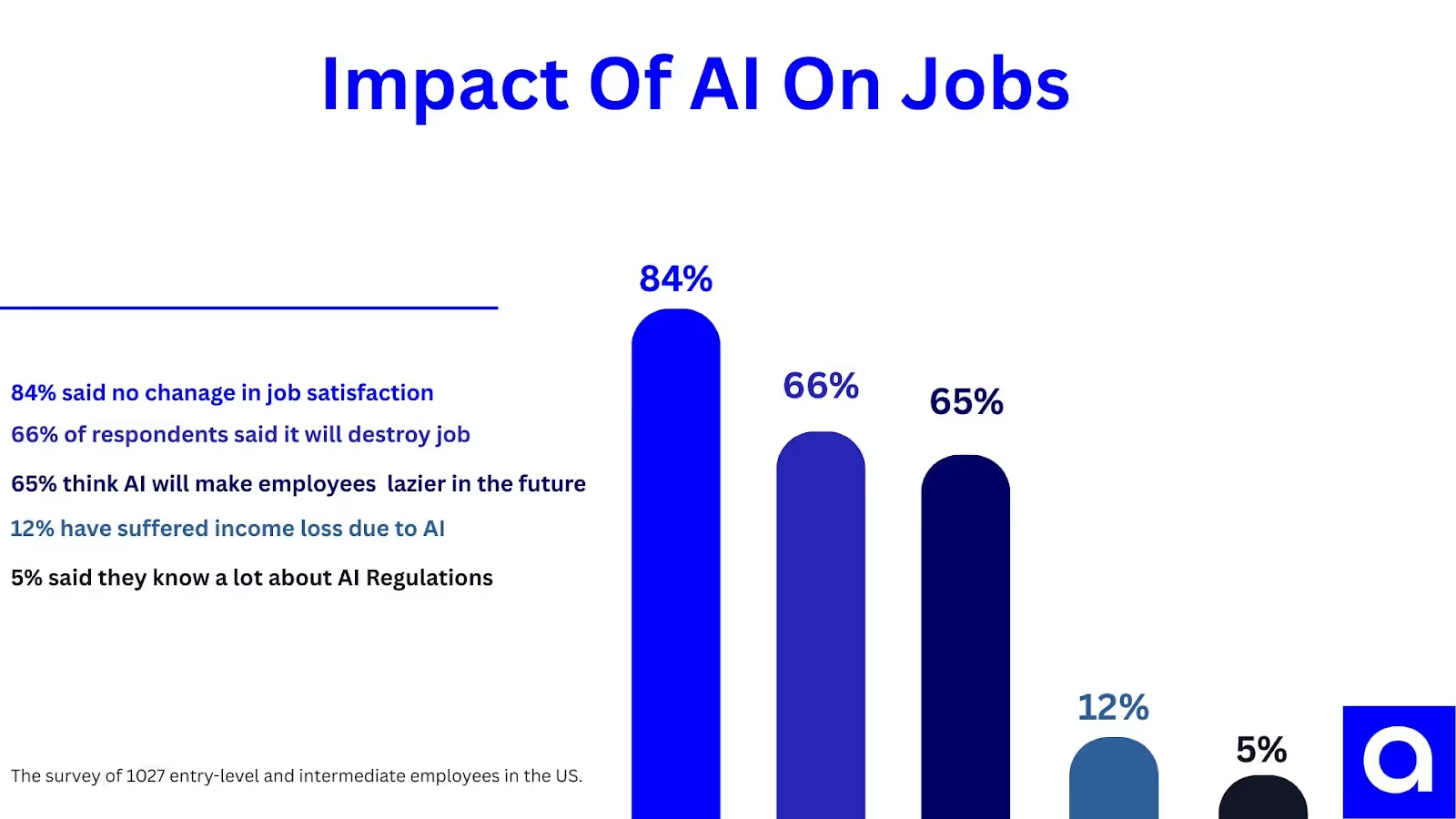
Trust & Transparency
- Only 46% of employees trust AI systems at work, despite over two-thirds using them regularly. Source
- A trust gap exists: just 53% of frontline employees trust their leaders to implement AI responsibly, compared to 71% among senior leaders—an 18‑point disparity. Source
- Globally, about 50% of employees are willing to trust AI in workplace decisions, though there’s strong resistance to its use in HR and performance management. Source
Optimism & Satisfaction
- Around 65% of workers express optimism and excitement about AI, with 50% currently using AI on the job, up from 32% last year. Notably, employees in India, 78%, and China, 77%, lead in enthusiasm compared to France, 32%, and Japan, 29%.
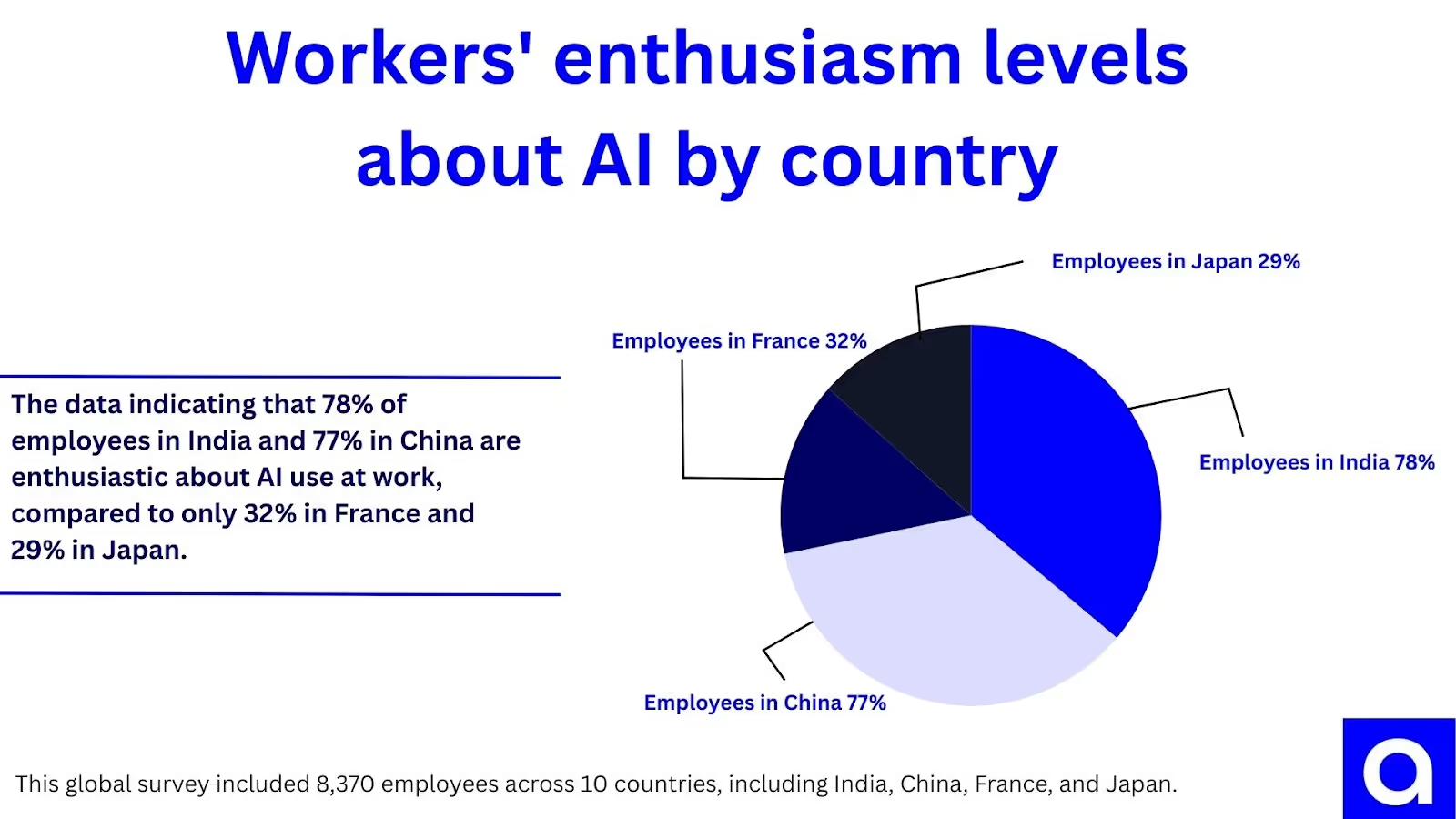
- As AI use increases, employees report higher productivity, better work–life balance, and greater access to information, especially among frequent users. Source 1, Source 2
Concerns & Ethical Worries
- Ethical concerns persist: 54% of professionals view generative AI as the highest-risk emerging technology, while only 27% of organizations have formal ethical guidelines in place.
- Fears related to job displacement and privacy are widespread: 77% worry about job loss, and 73% fear losing skills to AAI.
- Security and privacy concerns are cited by 31% and 30% of workers, respectively, as barriers to using AI at work.
How AI Affects Workplace Culture and Work-Life Balance?
Here’s what 2025 data reveals about how AI is shaping workplace culture and work–life balance, both positively and negatively:
Pros: Enhancing Positive Experiences
- 93% of UK data workers report a positive impact from AI use, with 82% stating that it helps them produce better work and 60% experiencing stress reduction. Source
- Among business leaders, 61% agree AI has improved their own work–life balance. Source
- A Tech.co survey finds that 93% of AI-using businesses are open to a 4-day workweek, compared to 44% of non-AI-using businesses. Source
- A field experiment across 6,000 knowledge workers showed AI integration reduced email time by ~25% (~3 hours/week). Source
- 70–94% of workers say AI saves them time, helps focus on critical thinking, boosts creativity, and increases job satisfaction. Source
Cons: New Challenges & Risks
- 16% increase in meetings after 8 pm and ~20% of employees checking emails on weekends indicate growing work intensification tied to remote/global collaboration.
- 47% of employees fear AI may replace their jobs in the next five years—those anxious about AI are 45% more likely to disengage, underscoring a cultural risk.
- Between 48% and 56% of professionals express concerns over AI surveillance, privacy, and algorithmic bias, especially in monitored environments.
- Around 63% of workers report at least some fear of AI, with 61% expecting burnout. Women are particularly worried about the negative impacts on their work-life balance, at 49%.
- 87% of workers say technology makes it harder to “switch off” after hours—a phenomenon called "leaveism."
How Many Jobs Has AI Created So Far?
While much attention is given to the jobs AI may replace, it’s equally important to recognize the new opportunities it creates. From AI engineering and data science to prompt writing, ethical oversight, and human-AI collaboration roles, AI is generating an entirely new class of jobs. As companies adopt AI tools, they increasingly need professionals to build, manage, and work alongside these technologies, changing the job market in ways that go beyond automation.
The conversation about AI and employment has been dominated by a single narrative: robots taking human jobs. This fear, while understandable, obscures a more complex and arguably more important story that AI is simultaneously creating entirely new categories of work that didn't exist five years ago.
We're witnessing something historically unprecedented. Generative AI is not only changing how we do existing jobs, but also spawning completely new professions at breakneck speed. From prompt engineers earning six-figure salaries to AI ethicists shaping corporate policy, we're seeing the birth of a new professional ecosystem in real-time.
The Hidden Job Market Revolution
What makes AI's job creation particularly fascinating is its visibility problem. When a factory closes, it makes headlines. When 10,000 new AI trainer positions are created across hundreds of companies, it barely registers in public consciousness.
Consider this paradox: while media coverage focuses on AI replacing customer service representatives, companies are simultaneously hiring AI conversation designers, human-AI interaction specialists, and algorithmic bias auditors are roles that simply did not exist in 2020.
The Challenge of Measuring What's New
Traditional employment statistics struggle to capture AI's job creation because:
- New roles emerge faster than classification systems can track them
- Hybrid positions blend AI skills with existing functions
- Many AI jobs are created within existing companies rather than new firms
- Freelance and contract AI work operates outside traditional employment data
The statistics that follow attempt to quantify this emerging landscape, but they likely undercount the true scope of AI-driven job creation. We're trying to measure a labor market transformation while it's still happening.
Two Parallel Labor Markets
What's emerging isn't a simple replacement scenario, but two parallel developments:
- Traditional roles being automated (often routine, repetitive work)
- New AI-native positions being created (often requiring human judgment, creativity, and AI collaboration skills)
The net effect varies dramatically by industry, geography, and timeline. The data reveals not just numbers, but the early indicators of how work itself is being redefined in the age of artificial intelligence.

New Careers Emerging from AI Adoption
As AI tech becomes more and more common in businesses, it’s opening up a whole new world of jobs. These roles are all about creating, managing, and fine-tuning AI systems, and demand for them is growing fast across different industries. From prompt engineers to AI product managers, the job market is evolving quickly to meet the needs of companies using AI every day.
Global Trends in AI Job Creation (2023–2027)
The AI world is booming right now, creating jobs all over the globe. Between 2023 and 2027, companies across industries are hiring more people as they embrace generative AI, automation, and smarter data tools.
Global Job Forecast Through 2030
According to projections by the World Economic Forum, while automation may impact specific roles, it will also drive significant job creation, especially in tech-driven sectors. Here's a closer look at what to expect by 2030.
- 170 million new jobs created
- 92 million jobs displaced
- Net gain of 78 million new roles
Within those five years:
- Tech-driven roles: +11 million jobs
- Tech-driven displacement: −9 million
- Net +2 million in tech-specific jobs by 2027
How Are Companies Preparing for AI Integration?
As AI becomes a cornerstone of modern business strategy, companies worldwide are actively preparing for its integration by investing in infrastructure, upskilling employees, updating workflows, and establishing governance frameworks. From small businesses to global enterprises, the focus is shifting toward adopting AI responsibly and effectively, ensuring that both technology and people are ready to work together for long-term success.
Are Businesses Offering AI Training for Employees?
- A ProfileTree analysis reports that only 38% of companies currently offer AI-related training to their staff, despite 82% of business leaders acknowledging its importance. Source
- A Microsoft Viva study found that 70% of organizations struggle to equip their workforce with AI skills, and 62% of leaders recognize an organization-wide gap in AI literacy. Source
- According to Gitnux, 70% of corporate training programs are projected to incorporate AI by 2025, with 48% of companies planning to increase AI training budgets by over 25% in the following year. Source
- In L&D, 30% of teams already utilize AI-powered learning tools, and 46% more plan to implement them within a year.
- A Revature survey indicates 56% of large organizations cite upskilling/reskilling—including AI training—as their top strategy for addressing IT skill gaps in 2025. Source
- The World Economic Forum reports that 77% of employers plan to reskill employees for AI collaboration between 2025 and 2030. Source
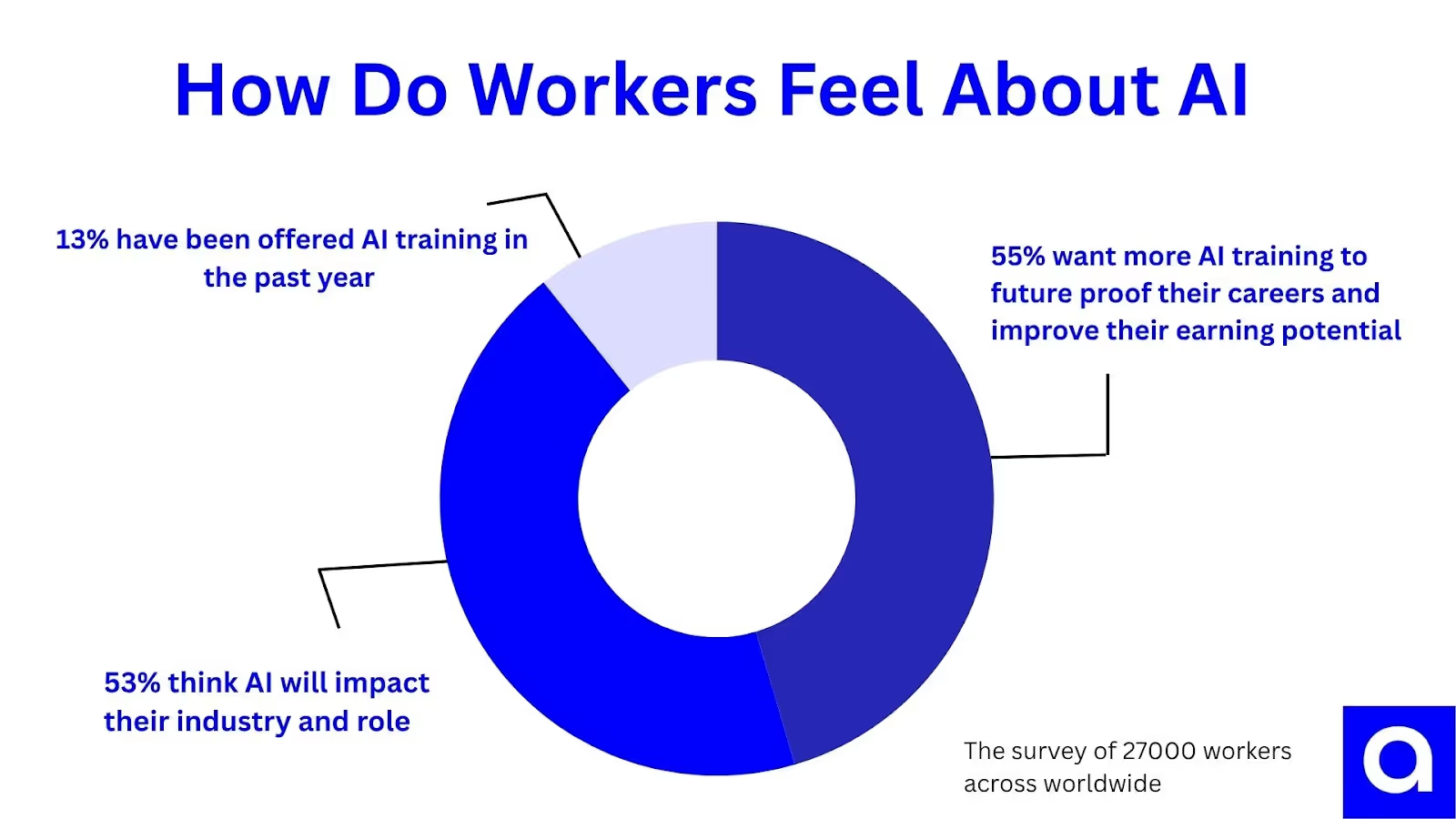
What Is the Business Impact of AI in the Workplace?
AI is reshaping the workplace by driving measurable improvements in efficiency, cost savings, and competitive advantage. Companies integrating AI report faster operations, smarter decision-making, and the ability to innovate at scale. Here's how AI is delivering business impact in 2025:
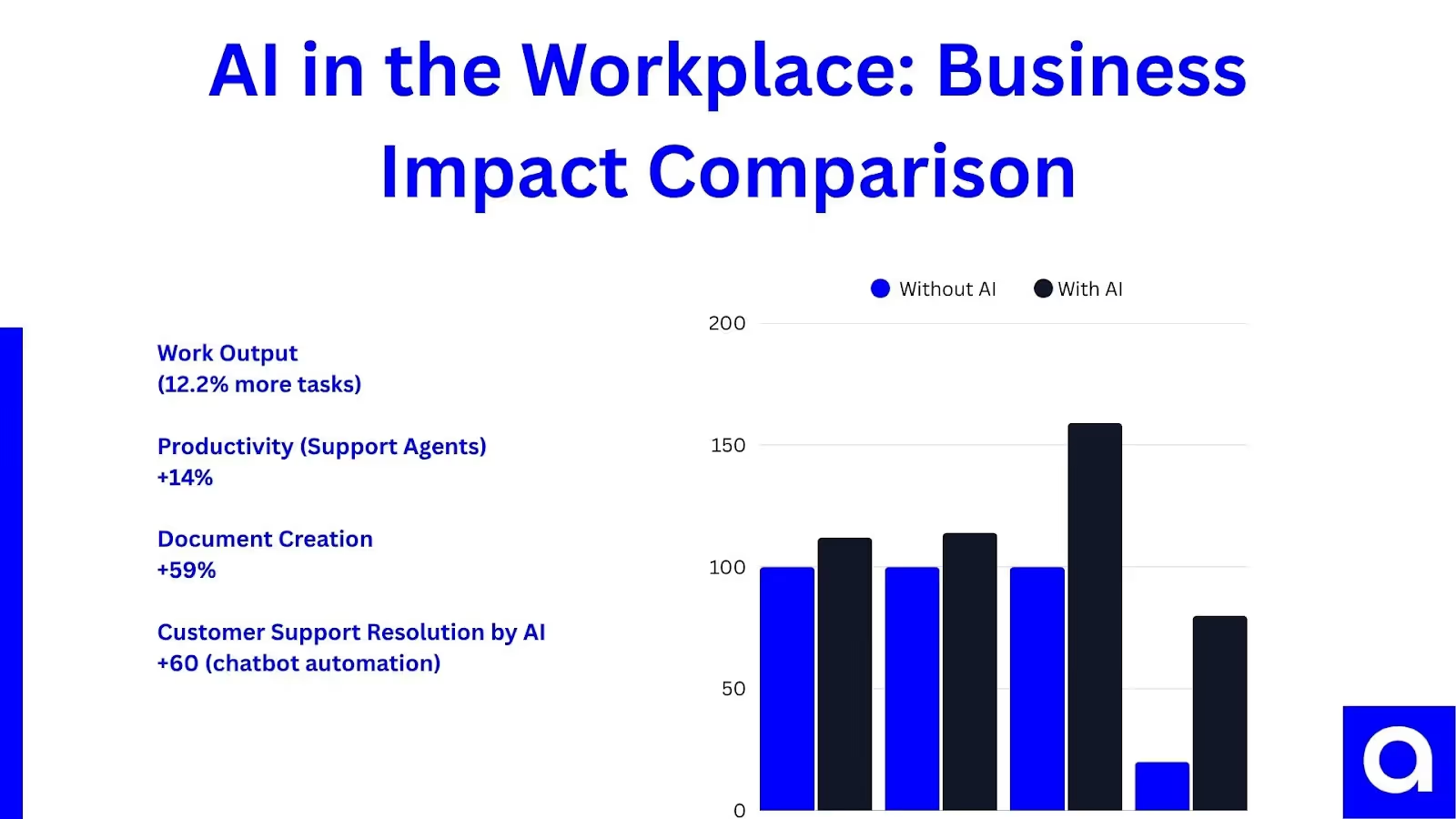
What Do Executives Say About AI’s Role in Growth?
- Sixty-eight percent of executives plan to invest between $50 million and $250 million in generative AI over the next year, with 56% anticipating a major business transformation within 12 months, and this expectation rises to 67% within two years. Source
- 65% of senior executives expect AI and predictive analytics to be key drivers of growth in 2025, with 53% reporting significant productivity gains, and 50% citing faster ideation and content production. Source
- 44% of C‑suite leaders would override their own decisions based on AI insights, and 38% would fully delegate decisions to AI tools. Source
- 55% report that AI-driven insights now frequently or routinely bypass traditional decision-making channels. Source
How AI Is Affecting Decision-Making and Revenue?
- 82% of businesses using AI in decision-making report gaining a competitive advantage, with 50% faster decision-making and 11% higher profitability compared to peers.
- AI achieves 25% efficiency gains and a 41% reduction in errors in decision-making processes.
- 44% of C‑suite executives say they trust AI enough to override their own decisions, and 38% would fully delegate decisions to AI systems.
- 63% of companies report revenue increases in AI-enabled business units, and high performers are 3x more likely to see over 10% gains.
- 44% of businesses using AI have achieved cost savings, with top performers often reducing costs by 10% or more, especially in manufacturing and supply chain.
- 66% of companies expect their revenue to grow through AI adoption, with 33% anticipating a revenue uplift of at least 10%.
- DigitalRoute's survey of CFOs found that 71% struggle to monetize AI, and only 29% have a transparent AI pricing and revenue model. Yet 64% say AI monetization is a board-level priority.
AI Job Market Outlook: What’s Ahead?
Looking ahead, both employees and companies will have to move fast to keep up with shifting roles, new skills, and an unpredictable job market. The future of work is changing quickly—with automation speeding up, people and AI teaming up in new ways, and a bigger focus than ever on learning continuously and staying flexible.
What Skills Will Be Most Valuable in an AI-Driven Economy?
In the AI era, a hybrid of technical fluency and human-centric skills is key:
- AI and data literacy: Foundational for understanding and leveraging AI tools—ranked highest among emerging skills in the 2025 WEF Future of Jobs report
- Critical thinking & problem-solving: Prioritized alongside creativity and resilience, making up core 21st-century skills needed to interpret AI output and handle complex challenges.
- Adaptability and learning agility: With ~39% of key skills expected to change by 2030, the ability to learn continuously and adjust to new technologies is essential.
- Social & emotional intelligence: Skills like empathy, communication, and ethical awareness are increasingly in demand, especially for roles with AI interaction.
Summary: To really thrive in 2025, it’s not just about knowing AI—it’s about mixing that with good old critical thinking, being adaptable, and having strong people skills. These are the human qualities that AI just can’t replicate.
Expert Opinions: What’s Next for AI and the Future of Work?
As AI continues to weave its way into various industries, experts are on the same page: the future of work won’t be all about machines taking over, but rather about how humans and AI can work together. This partnership will drive innovation and highlight the pressing need for upskilling. Here’s what some of the top voices in the field are forecasting:
Predictions from Industry Leaders
- Satya Nadella (CEO, Microsoft). “Every employee will become more productive with AI as their copilot. The future of work will not eliminate jobs—it will transform them.”
- Sundar Pichai (CEO, Google/Alphabet). “AI will be more profound than the invention of fire or electricity. It will reshape how we live and work in the next decade.”
- Fei-Fei Li (AI Researcher, Stanford University). “The future of AI must be human-centered. Jobs will evolve, but empathy, creativity, and ethical judgment will remain irreplaceable.”
- Reid Hoffman (LinkedIn Co-Founder). Like spreadsheets revolutionized accounting, AI will revolutionize nearly every white-collar profession—but it will also create new roles we haven’t imagined yet.”
- Ginni Rometty (Former CEO, IBM). “AI won’t replace people. But people who use AI will replace those who don’t.”
- Eric Schmidt (Former CEO, Google). “Each and every one of you has a reason to use this technology. If you're an artist, a teacher, a physician, a business person, a technical person. If you're not using this technology, you're not going to be relevant compared to your peer groups and your competitors and the people who want to be successful. Adopt it, and adopt it fast.
Strategic Advice from Experts
- Invest in reskilling: The World Economic Forum says that nearly half of the skills workers rely on today will shift by 2027. That’s why ongoing learning and helping employees grow with the times isn’t just a nice-to-have — it’s essential for staying competitive.
- Prioritize responsible AI: Leaders urge firms to incorporate ethical frameworks, governance, and transparency into their AI tools from the outset.
- Embrace augmentation, not replacement: Many experts believe the future belongs to organizations that utilize AI to enhance human talent, rather than eliminate it.
- Build hybrid teams: Combining human judgment with machine intelligence will be a key competitive differentiator across industries.
Experts generally agree that AI is poised to transform the future of work. However, the biggest benefits will be reaped by those who embrace it, learn from it, and view AI as a helpful tool rather than a threat.
AI in the Workplace FAQs
Q1: How are employees using AI today?
More and more employees are using AI to help with everyday tasks, things like writing emails, analyzing data, managing their schedules, handling repetitive work, and creating content. Tools like ChatGPT, Microsoft Copilot, and Grammarly have become go-to favorites for making work a little easier and more efficient.
Q2: Does AI replace human jobs?
In some industries, AI is taking over routine or repetitive tasks, which can lead to some jobs being phased out. But it’s not all loss — AI is also opening the door to new opportunities. Roles like AI trainers, prompt engineers, and AI ethics specialists are popping up, especially in companies that are leading the way with tech.
Q3: What industries are most affected by AI?
AI is widely used in finance, healthcare, retail, manufacturing, marketing, and logistics. It helps streamline workflows, improve accuracy, and deliver faster customer service in these sectors.
Q4: Are companies offering AI training to employees?
Yes, and it’s becoming more common. As of 2025, around 4 in 10 companies are providing AI-related training, and that number is still growing. Most of these programs focus on helping employees understand how AI works, how to work with data, and how to use tools like prompt engineering in their daily tasks.
Q5: What are the biggest benefits of using AI at work?
- Faster decision-making
- Reduced manual workload
- Increased productivity (up to 20%)
- Enhanced customer experiences
- Competitive advantage
Q6: What are the risks or challenges of AI in the workplace?
- Job displacement in routine roles
- Data privacy concerns
- AI bias and ethical issues
- Over reliance on automated systems
- Lack of proper governance
Q7: Will AI fully automate most jobs?
Not quite. AI is here to support what people do, not replace them. Jobs that rely on creativity, emotional intelligence, and big-picture thinking are still best handled by humans, and that’s not likely to change anytime soon.
Q8: How can companies prepare for AI integration?
Organizations can prepare by:
- Investing in training
- Defining AI policies and ethics
- Ensuring data security
- Testing small AI pilots before scaling
- Encouraging a culture of adaptability
Artificial intelligence is quickly transforming the workplace, presenting fresh opportunities along with various challenges. Understanding these statistics is important for businesses and workers to adjust, innovate, and succeed in a world that's becoming increasingly driven by AI.
References
- AIPRM. AI in Workplace Statistics.
- All About AI. AI Statistics in the Workplace.
- All About AI. AI Replacing Jobs Statistics.
- ArXiv. AI & Productivity Studies.
- Axios. Small Business AI Use Report.
- Boterview. AI Job Replacement Stats.
- Business Insider. Late-Night Work & AI.
- Business Today. WEF: 39% of Skills Outdated by 2030.
- Cognitivetoday. AI Job Market Impact.
- Converzation. Collaboration Statistics.
- Deel. Workplace Stats.
- DesignRush. AI Company Trends.
- Eagle Hill Consulting. AI Use Among U.S. Workers.
- Econsultancy. Adobe Digital Trends 2025.
- Euronews. Workplace AI Trust Survey.
- Fast Company. AI Work Survey.
- Forbes. AI & Work-Life Balance.
- Gallup. Workload Trends.
- Gitnux. AI in Corporate Training.
- Grammarly. Workplace AI Use Study.
- Henley Business School. AI Saving Time.
- HR Dive. AI-Fueled Errors Report.
- IDM. Global AI Use Survey.
- Juliety. AI Job Statistics.
- Keevee. AI Replacing Jobs Stats.
- KPMG. AI Trust Report (U.S.).
- MBS. Global AI Trust Study.
- Mezzi. AI Adoption by Industry.
- Microsoft Viva / Tech Community. AI Skills Gap.
- NY Post. Escaping Repetitive Tasks with AI.
- Oracle. Robots at Work Survey.
- PR Newswire. U.S. AI Workplace Usage.
- PwC. AI Jobs Barometer.
- PwC. AI & Productivity Report.
- Qualtrics. Executive vs. Employee AI Viewpoint.
- Reddit (r/AiForSmallBusiness). SMB AI Tool Analysis.
- Reuters. Google Study: 122 Hours Saved.
- SAP News. Executive Trust in AI.
- Seosandwitch. AI in HR Statistics.
- Sequencr. Key GenAI Statistics.
- TalentLMS. AI at Work Survey.
- Tech.co. AI & 4-Day Workweek Study.
- The Conversation. Global Trust in AI Study.
- The HR Director. AI & Workplace Behavior.
- The Times (AU). Inappropriate AI Use at Work.
- Tribune (Pakistan). AI Job Replacement Report (WEF).
- UNLEASH. HR + AI Insights: WEF.
- Washington Post. Programming Jobs Lost to AI.
- WEF (World Economic Forum). Future of Jobs Report 2025.
- WiredGorilla. AI Adoption in 2025.


.avif)
